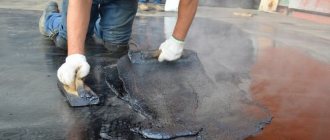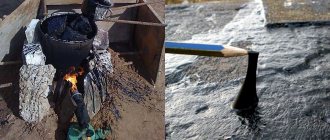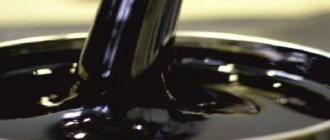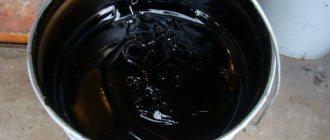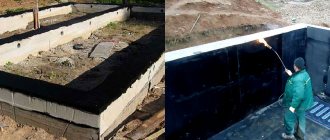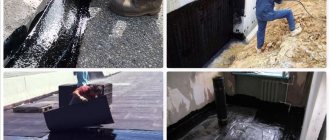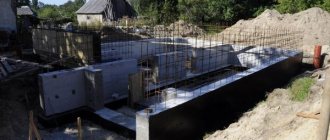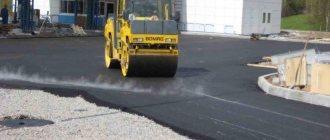When restoring a roof or insulating a basement, the question often arises: how to dilute the bitumen? Roofs on new buildings are rarely filled with it, since today there are many more attractive options for its insulation and covering. But on old houses, over the decades of their existence, such a layer of roofing material has accumulated that, apart from bitumen, there are practically no restoration options left (after all, it is sometimes not even possible to remove multiple layers).
Dismantling roofing felt “pies” is so labor-intensive that people try to push it as far into the future as possible, especially if the building is not residential - a garage, barn, summer kitchen, extension. And for coating waterproofing of foundations, bitumen still remains one of the most popular materials - cheap, quite reliable, available for independent use, even if the work involves hard physical labor and some danger in carrying out it. True, if the goal is to obtain the most reliable foundation waterproofing possible, it is better to glue waterproofing or the same roofing material over the bitumen. Left alone, the bitumen coating quickly cracks and begins to let moisture through.
How to dilute bitumen in private construction or renovation?
As you can see, this issue still remains relevant when constructing foundation protection and when repairing old roofs. Therefore, it is worth taking a closer look at this, which is what we tried to do in this article.
Features of bitumen processing
Gone are the days when bitumen existed only in one, solid, variety. Now there is quite a wide variety of waterproofing materials of this type:
- hard bitumens;
- liquefied bitumen;
- bitumen-rubber mastics;
- bitumen-polymer mastics.
All solid variations require melting.
It is impossible to dilute bricks in any solvent. To some extent, bitumen will transfer into it, but it will be quite insignificant. Often this solution is used as a primer - a primer for bitumen waterproofing. The primer is made as follows:
- Bitumen breaks into small pieces. It is advisable to carry out this operation in the shade - when heated in the sun, it becomes sluggish and splits reluctantly.
- The fragments are immersed in diesel fuel or used oil. By volume - so that the solvent covers the pieces completely, but does not form a large layer above it.
- When the liquid turns the color of bitumen, it is ready to be used as a primer.
How to melt lump bitumen
If we consider solid bitumen as a waterproofing material, then it must be melted before use. And this step cannot be avoided. Moreover, in its pure form, bitumen is not very suitable for application (and continued existence with operation).
Firstly, it hardens too quickly.
Secondly, it does not fill the pores too tightly - it is too viscous and dense.
Thirdly, very soon the layer begins to crack. Therefore, when working with bitumen, the following algorithm is usually followed:
- Bitumen, broken into pieces, is melted in a metal barrel over low heat. Moreover, the fire should be as slow as possible: with rapid combustion, in some places the material already begins to coke from overheating, while in others it still remains solid.
- After melting, it is left on the fire until foam stops appearing, that is, dehydration stops.
- Filler is poured into the container, the best choice being dissolved asbestos, but it is quite difficult to find. So usually cement, chalk, gypsum (including alabaster), talc, ground clay, etc. are taken. Pursued goal: preventing the formation of pores by coating.
- When the filler is mixed, a solvent is added - it will prevent the bitumen from hardening too quickly. The approximate ratio of the components is as follows: half the volume is bitumen, 30% is diesel fuel, the rest is fillers.
It remains to add a couple of clarifications
. Firstly, do not forget that bitumen is a flammable material and can burst into flames if overheated or too intensely heated. It is useless to extinguish it with water; you need to keep a tin lid on hand to stop the access of oxygen. You need to be especially careful after adding diesel fuel: in its pure form, bitumen ignites at 230 degrees, with a solvent the flash point is significantly reduced.
Second: many suggest using waste, gasoline or kerosene as a solvent.
If we can completely agree with the first option, then the last 2 are no good: the substances are very volatile and flammable. Most of it will evaporate before it fulfills the purpose of the solvent, the rest will increase the flammability significantly.
Liquefied bitumen
There is no need to heat it, it is already in a consistency suitable for application. However, it may thicken over time. In this case, the following are used to dilute it:.
- low octane gasoline. On the one hand, it is a cheaper and more accessible solvent, but the fire hazard is high, as is evaporation. The presence of open sources of fire (in particular, smoking) is unacceptable, and there is a risk of inhaling vapors to the point of poisoning; White spirit is more expensive, but much safer.
- The solvent must be added little by little, stirring constantly. Remember that it is lighter than bitumen and collects on the surface. If you accidentally overfilled it, you can wait for separation and simply drain off the excess.
Bitumen mastics
The solvents remain the same regardless of whether the second component is rubber or polymers. Mastics are good because they can be used when it’s already cold outside. In addition, they do not need heating. However, at low temperatures, mastics become too viscous. Solvents are added to overcome their reaction to frost. You can use them as:
- gasoline - works great, but the mentioned disadvantages do not go away;
- kerosene. Preferably an aviation one, which may cause problems. Household ones are not clean enough and can deteriorate the quality of insulation. In addition, it, like the previous position, is flammable and volatile;
- White Spirit. The only downside is the cost. Despite its relative cheapness, it is needed in large quantities, so it will cost a pretty penny;
- turpentine: thins mastic quite well, inexpensive, less volatile and flammable than gasoline and kerosene, but the smell is very characteristic;
- nefras, also known as gasoline “galoshes”;
- acetone, solvent, 646. The most suitable solvent will be the one recommended for a specific type of mastic by its manufacturer. So before deciding how to dilute bitumen or mastic from it, read the manufacturer’s recommendations.
Mastics can have different properties and characteristics - this is due to different additives in the mixture. Initially, bitumen and rubber-bitumen mastics are thick. And for effective use they must be diluted. How to do it right? Let's see how to dilute bitumen mastic and how to prepare it.
Classification
Each material is classified according to its composition according to different criteria. Thus, the compositions are divided according to the conditions of use, as well as additives. Mastics also differ in technological features. They differ in their ability to operate at a certain temperature and conditions that ensure the process of hardening and softening.
For example, hot compositions should first be heated to temperatures of 160 degrees and above. After this, you can use the finished product for insulation work. Cold mixtures are used differently. In this case, you will have to make a solution. How to dilute rubber-bitumen mastic depends on the application method and other factors. Cold types of mastics should not be heated. Solvents are highly volatile and will evaporate from the surface during the curing process.
According to the method of preparation, all compositions are divided into one- and two-component. Materials from the first group are prepared as simply as possible. The mass can be used immediately without the need to add any ingredients.
Two-component materials must be prepared, after which they are ready for use. How bitumen mastic can be diluted depends on where and how the insulation work will be carried out.
Roof repair with bitumen mastic
Before application, the roofing mastic (cold) is thoroughly mixed. When specified by the manufacturer, the composition is diluted with solvents. With such mastic it is possible to work at low temperatures. To do this, the insulating agent is heated indoors for 24 hours. Make sure that the temperature is above 15 degrees. Before starting the procedure, the surface should be cleared of snow, dirt, ice and deformation coating. The porous surface of the plane is treated with bitumen primers.
The coating area should be dried if the manufacturer does not indicate on the packaging the possibility of treating wet surfaces.
When pouring, the mastic is leveled with a mop, then applied with a spatula or brush. The product is applied in 2-3 layers, with breaks to achieve operational consistency. The total thickness is 1-3 mm.
Surface treatment using this mastic is carried out under the following conditions:
- no precipitation;
- temperature above minus 5 degrees.
Hot roofing mastic is a flammable material. In this regard, insulating work with it is carried out away from any source of fire, in the open air. Personnel should wear protective work clothing to avoid contact of hot mastic with exposed skin.
What is better: metal tiles or ondulin? Comparative analysis of these materials.
And in this article there is a video on how to properly cover a roof with corrugated sheeting.
The diagram of the rafter system of a gable roof is available at the link https://rooffs.ru/stropilnye-sistemy/dvuhskatnaya-krysha/raschet-i-ustroystvo.html
What is used for breeding?
Depending on where the material will be applied, the proportions and density are changed. Otherwise, the composition simply will not be able to stay on the surface before it dries completely. Mastics are different, which means the products for breeding will also be different.
Most often used to dilute materials:
- Motor gasoline or kerosene.
- White Spirit.
- Gasoline "Galosh".
In most cases, low-octane gasolines are used as diluents. The polymerization process of the dissolved composition takes 24 hours after application. This is provided that the work is performed outdoors.
When choosing how to dilute bitumen mastic, you should definitely remember that even low-octane gasolines are flammable liquids. Vapors from any fuel are flammable. During waterproofing work, you should not use open fire.
As for the proportions, they must correspond to the volume of the base used. If you violate them, the mixture will dry out more slowly or the fluidity of the solution will increase. As a result, adhesion will decrease or beneficial properties will be lost. In this case, the material will not have protective functions.
How can you dilute rubber-bitumen mastic? There are other materials. This is turpentine, any kind. It is not recommended to use acetone or liquids based on it for these purposes. Some craftsmen dissolve mastic in diesel fuel. As a result, the mixture turns out to be heterogeneous. However, this solution fills all cracks and irregularities with the highest quality possible. If the mastic is liquid, it has better adhesion and good insulating properties.
Recommendations for preparing bitumen mastic
Firstly, the preparation time for bitumen mastic must be at least 3 hours.
Secondly, to obtain a high-quality and homogeneous substance, it is very important to maintain a given temperature regime (about +190 ⁰C) and not allow significant temperature changes. One should take into account the fact that a significant increase in temperature can lead to thermal decomposition of ingredients and, as a result, cause damage to the construction product. You can find out about the overheating state of the material by an indirect (visual) method, since it is during overheating that yellow-green stains and bubbles appear on the surface of the mastic.
Thirdly, it is recommended to use the finished mastic within 24 hours after its preparation. Well, in order for the material to be easily applied to a given surface, before using it, it is advisable to pass the liquid mastic through a metal sieve.
And of course, an important factor when carrying out work is full compliance with safety regulations and careful handling of flammable materials. For greater confidence, it is advisable to equip the work site with containers of sand.
Elastic and special additives in mastics
Gasoline, kerosene, and white spirit are universal solvents. But when choosing what to dilute rubber-bitumen mastic with, the first step is to decide what characteristics are needed from the solution. Depending on the additives used in the composition, materials are divided into:
- Bitumen-rubber.
- Bitumen-polyurethane.
- Bitumen-latex.
- Oil and rubber mixtures.
As you can see, bitumen is present in the composition of each material. But additives are different everywhere - hence the different properties. So, with the addition of polyurethane or rubber, you can get additional elasticity. This is important for most insulation work.
As a result, a strong film is formed that is difficult to break. The film can easily be stretched 20 times or more without being deformed. One of the options for diluting cachuco-bitumen mastic for roofing is motor gasoline.
Properties of bitumen mastic for foundations
For waterproofing the foundation, bitumen mastic is an indispensable product. There are two methods of waterproofing: the first is a mastic adhesive between the surfaced material and the base of the foundation, and the second is applied directly to the base of the foundation in layers. Due to the qualities of the components, the substance has the following properties:
- Covers the base of the foundation with a moisture-proof film with high physical characteristics. It is durable, does not crack, is resistant to temperature changes and is not afraid of water.
- Mastic resists the appearance and spread of mold and mildew along the foundation.
- The mass closes pores and minor defects in the foundation base - chips, cracks, etc.
- It has high adhesion to any type of foundation base.
- Membrane with high elasticity and resistance to mechanical stress.
Additives to mastic for roofing work
Experts, answering the question of what to dilute with, recommend adding crumb rubber in addition to solvents. This coating will be strong and durable. And it can be applied to any type of surface. The material prepared in this way can withstand mechanical stress, shock and vibration.
If you add rubber to the sucking mixture, you can prepare a cold mixture that does not require heating. In addition to high waterproofing properties, the material also acquires antiseptic characteristics along with high heat resistance.
Also for roofing work, you can add liquid latex in the form of an emulsion to the mastic. This is nothing more than synthetic rubber. The product is extremely easy to prepare and apply, and has excellent performance characteristics. The mixture is ideal for roofing work.
What is rubber-bitumen mastic
This waterproofing material is a plastic composition based on tar or petroleum bitumen. It also contains rubber, solvent, mineral fillers, additives and additives.
The technical characteristics of bitumen-rubber mastic are as follows:
- water resistance, moisture resistance;
- elasticity, plastic properties;
- strength qualities;
- hardness of the protective layer;
- heat resistance;
- viscous consistency;
- excellent adhesion to most surfaces;
- significant temperature range: – 50…+110оС;
- wide color palette;
- resistance to aggressive chemicals and solutions;
- anti-corrosion properties;
- resistance to UV rays.
Bitumen-rubber mastic has its advantages and disadvantages. The first is the ability to organize high-quality waterproofing on uneven surfaces. Even with economical consumption, the coating is solid, seamless, strong and durable. When dry, the paste has little weight.
Among the disadvantages, it can be noted that the quality of the working surface will entirely depend on the conditions under which the mastic was laid. When laying the coating, it is necessary to exclude the possibility of atmospheric phenomena such as wind, rain, snow. In this case, the air temperature should be above +5 degrees. Cold pastes and solutions can be used for external and internal work; hot mastics cannot be used indoors.
How to prepare the right solution
An important point in the process of preparing mastic is the method of applying it to the surface to be treated. The protective solution can be applied either manually or using special equipment. The manual application method is relevant when the amount of work is small. If it is necessary to apply the composition over a large area, then mechanized application methods are used. The method of mixing depends on how the mastic will be applied. How to dilute rubber-bitumen mastic? Before you start preparing the mixture, you need to prepare the surface on which the composition will be applied.
If peeling is observed on the coating, it should be thoroughly cleaned and then dried. After this, it is recommended to apply a layer of primer that can interact with mastics. These primers are called bituminous and are sold in ready-made form. But you can prepare it yourself. Next we will tell you exactly how.
Bitumen mastic for roof waterproofing - types, properties, application
The modern construction market has a wide range of materials for waterproofing, varying in price and characteristics, but the most popular product in this segment is still bitumen mastic. Liquid rubber bitumen is considered a high-quality, inexpensive, universal product with economical consumption and a long service life. Thanks to different release forms and application methods, it can be used both for constructing roofs and for repairing them with your own hands. In this article we will tell you how to properly use bitumen mastic for roof waterproofing.
How to prepare a primer
The use of a primer is a guarantee of reliable adhesion of waterproofing materials to porous and non-smooth surfaces. The composition is suitable for priming concrete bases and cement-sand screeds.
The primer is a solution of petroleum bitumen. The softening temperature of the material is 80 degrees or more. For those who do not know how to dilute bitumen mastic, experts recommend using organic solvents. What could it be? This is kerosene, nefras, gasoline. They are added in proportions of 1 to 1 or 1 to 5 by weight of the base.
To make a primer you will need clean bitumen - several pieces are needed. Next, the bars are dissolved in gasoline or in First, a solvent is poured into the prepared container - gasoline or waste. Next, the liquid is heated, and then crushed bitumen is added to the container.
The solution is heated to temperatures from 190 to 200 degrees. During the heating process, you need to constantly stir the mass. Next, prepare a container that can withstand high temperatures. Its volume is determined by the amount of solution. For small areas, a bucket is suitable. It is enough for several square meters.
DIY mastic
To make mastic yourself, you will need:
- pieces of pure bitumen,
- fillers,
- plasticizers.
Let's say you want to get 10 kilograms of the finished mixture. Then take 8.5 kg of pure bitumen, 1 kg of filler (forest moss or sawdust, peat, mineral wool, rubber crumbs, asbestos), 0.5 kg of plasticizer (waste oil). It is best to cook mastic in special cauldrons equipped with thick (at least 3mm) walls and a lid. Such walls will allow the heat to be evenly distributed so that the bitumen does not burn.
Cooking rules
- The boiler can be loaded no more than 70%. Otherwise, the mastic may spill out.
- The boiler must be installed not directly on the fire, but away from it on a stand.
- It is best to maintain the cooking temperature within 190C. At higher temperatures, bitumen may decompose.
- Try to avoid temperature changes - in the end you will end up with a mastic that is homogeneous in composition. How do you know if the temperature is too high? Very simple. The first sign of overheating is the appearance of yellow-green bubbles.
Cooking process
- Before starting cooking, crumble large pieces of bitumen into smaller ones, clean them of dirt and sand.
- The entire process of melting bitumen should proceed very slowly, over about three hours.
- The filler must be crushed, dried and heated.
- Fillers and plasticizers should be introduced gradually.
- The boiling mixture must be stirred regularly (using a shovel) and the foam removed from it.
- After the foam has subsided and the surface of the mixture becomes completely smooth, you can add a plasticizer.
- Then mix everything thoroughly again.
- That's it - the mastic is ready.
Best before date
It is advisable to boil the mastic immediately before using it. It cannot be stored longer than 24 hours. During use, the mastic must always be hot (approximately 120 ° C).
DIY primer
It is not advisable to apply mastic to bare surfaces. The surfaces must be given good adhesion in advance, for which they are cleaned of debris and primed. Priming will ensure a high level of strength of the applied mastic layer.
The composition of the primer is simple: a solution of bitumen plus gasoline in a ratio of one to three.
Cooking process
- In order to prepare the primer, you need to place hot (about 70 ° C) bitumen in gasoline.
- Bitumen is added in small portions and mixed until completely dissolved.
- To avoid the presence of solid inclusions, the primer can be filtered through a fine metal mesh.
Application
The primer must be applied in two layers (or three layers). Wait 10-15 minutes before applying subsequent layers. Then the surfaces are covered with mastic.
The foundation of the house is subject to constant destructive influence from various environmental factors. Particularly active is the water that is contained in the soil and penetrates into it after precipitation. When constructing the foundation, it is necessary to provide additional protection from this influence. The most commonly used is bitumen mastic.
Roof mastic. Laying method
It is worth immediately noting that mastics are used on roofs with a slope of up to 10-15 degrees, since precipitation does not linger on a steeper roof, therefore, it is not advisable to increase its waterproofing properties. Bitumen mastic for roof waterproofing can be installed in two ways.
- Hot method.
The mastic is applied at a temperature of 70 to 150 degrees, however, it can be higher, it all depends on the composition of the product. This technique can only be carried out with the independent production of the required mixture, because it is impossible to transport it hot. In addition, the mastic turns out to be of rather poor quality, and its overconsumption is much higher than the norm; - Cold method.
Applying the cold mixture differs significantly from the method described above. Here you don't have to worry about burns or fires. Optimal conditions for application are any positive temperature up to 5 degrees. In cases where it is necessary to carry out work at lower temperatures, heating the mixture to 70 degrees is allowed. Cold bitumen roof mastic has a special composition that penetrates into the base of the rolled material and holds them together at the molecular level. This mixture must be applied in a thin layer. By the way, it is not necessary to clean the base from dirt, the main thing is that there is no vegetation or large debris on it.
In the first case, thanks to the high temperatures, the adhesion of the mixture to the base goes well; as for the second, the indicators are identical. If we conclude, both methods provide good adhesion. You can lay layers after applying a hot or cold mixture within an hour. By the way, you can purchase hardening and elastic mixtures at a hardware store. They are purchased depending on the properties of the roofing and the atmospheric characteristics of your region.
Why is coating waterproofing with bitumen necessary?
In its classic form, bitumen mastic is a mixture of several components that reliably and tightly cement cracks in the surface of the base and prevent moisture from penetrating into the foundation structure.
The mastic hardens quickly due to the use of various solvents and other elements that ensure the effectiveness of the solution. Using mastic it is possible to create highly effective seamless surfaces. This is true for the roof and walls, and certainly for the foundation.
Before using mastic, it is important to know how and with what to dissolve the resin for painting the foundation. The effectiveness of the subsequent operation of the protective layer depends on the correct combination of elements.
How to dilute bitumen mastic
To find out exactly how to dilute resin for painting the foundation, you need to understand what indicators you want to get. The proportions in which the components in the mastic are combined determine not only the thickness, but also the performance characteristics of the solution. Among the substances used to dissolve the mastic, the following are used:
- Gasoline (kerosene).
- White Spirit.
- Gasoline galoshes (Gasoline solvent for the rubber industry).
Choosing the right substance and amount of material that needs to be used to dilute bitumen for the foundation means preparing the optimal material for processing the foundation.
What additives are used to dilute mastic?
It is possible to add various filler options to the created solution. Therefore, the builder should decide what parameters he wants to achieve in the end.
Now the most popular types of mastic are the following:
- bitumen-rubber mastic,
- polyurethane,
- latex,
- oil, rubber.
If we take bitumen-rubber mastic, then its composition is based directly on bitumen and polymer.
Polyurethane and rubber form additional plasticity in the solution, in which the resulting film is not only durable, but can stretch approximately 20 times.
The use of rubber to prepare a cold mixture allows you to create a material that does not require preparation before use. The mastic is applied evenly and is uniform and durable.
The addition of oil components helps prevent the material from hardening. Such compositions are necessary for waterproofing pipes and pipes that will be placed underground.
Cooking features
The process of making bitumen mastic is not complicated; you just need to choose the right ingredients and follow the basic rules of preparation.
To complete the work, the following elements are required:
- pieces of bitumen, cleaned of contaminants;
- specially selected fillers,
- various plasticizers.
For example, to create waterproofing you need to have approximately 10 kilograms of mastic. This will require approximately 8 kg of bitumen, 1 kg of filler and 500 grams of plasticizer.
For cooking mastic, durable cauldrons with a wall thickness of 3 mm or more are selected. There should also be a lid. Thanks to the heating of the walls, the bitumen warms up evenly.
The boiler should be loaded no more than 70% - otherwise the mastic may start to splash out. For cooking, the following rules must be strictly followed:
- The boiler is not placed above the fire, but is installed to the side.
- The temperature should be at 190 degrees, which does not lead to decomposition of the material.
- Temperature changes are unacceptable, which can lead to the formation of a heterogeneous mass of mastic.
- To prepare the mixture as quickly as possible, it is necessary to divide the bitumen into small pieces.
- Cooking the mastic should occur slowly and evenly.
- Filler and additives should also be crushed.
- The addition of components is carried out gradually.
- The solution is stirred regularly and the forming foam is periodically removed.
- After the foam disappears, fillers can be added.
- After adding, the resulting solution is thoroughly stirred - and the bitumen mastic is ready for use!
Now that you have learned how to dilute bitumen mastic for the foundation and how to prepare it, you should know how to apply it to the surface correctly.
How to apply bitumen mastic correctly
After preparing the mastic, it should be applied correctly to the surface. There are 2 methods for this:
- Application by hand.
- Mechanized method of application using special tools.
The manual method of work is optimal when performing a small amount of work. For large areas of work, manual technology is impractical, so mechanisms are used. The tools are also used to work in hard-to-reach places.
Before application, the surface to be treated should be prepared. The surface is cleaned and thoroughly dried. After this, a thin layer of primer is applied, which ensures interaction with the mastic.
Once the mixture is ready and sufficiently warmed up, you can proceed directly to application. To do this, use a regular roller or brush - the choice of a specific tool depends on the nature of the surface, volume and complexity of the configuration of the foundation, wall or roof. Sometimes a wide spatula is used for application.
The layers of mastic are applied with an overlap, which should be approximately 10 centimeters. This prevents the formation of empty parts that will be exposed to moisture penetration.
The application of the next layer of mastic begins after the previous one has completely hardened.
The use of bitumen mastic for waterproofing the base is an important factor in protecting the structure and preventing the formation of microcracks and damage.
An effective protection against the destructive effects of moisture on concrete, metal, wood and reinforced concrete structures is bitumen waterproofing. It is used for coating foundations, concrete floors, walls and ceilings of basements, interfloor ceilings, treating bathrooms, showers, etc. This prevents moisture from penetrating into the house through small pores and cracks and ensures the durability of the structure.
Features of using bitumen waterproofing
To treat the main elements of the house, solid and liquefied bitumen, bitumen-rubber and bitumen-polymer waterproofing mastics are used. When working with solid materials, melting them is mandatory. In this case, the question is “how to dilute bitumen mastic?” does not arise. During the smelting process, the bitumen is dehydrated. In addition, the concrete base itself is thoroughly dried before applying waterproofing. Otherwise, there is a risk that when hot resin hits the surface of the concrete, boiling will occur and bubbles will form under the insulating layer. This means that the waterproofing will not clog the cracks and pores of the concrete.
Hot compounds can be applied with a wide brush or brush, overlapping strips of 10-15 cm. The only drawback of working with hot bitumen mastic is the high hardening speed.
Liquefied waterproofing does not require constant heating. Before you begin application, you should dilute the bitumen mastic with a solvent. Most often, low-octane motor gasoline acts as a solvent. Polymerization of the liquefied composition occurs 24 hours after application, provided that the work is carried out outdoors. When choosing how to dilute bitumen mastic, you should remember that gasoline is a flammable substance, and its vapors are explosive. During waterproofing work, the possibility of open fire should be excluded, and smoking is strictly prohibited.
How to dilute bitumen-polymer mastic?
Bitumen-polymer waterproofing can be used at low temperatures. In addition, solvents can be added to them. When deciding how to dilute bitumen mastic, choose one of the options below:
- petrol
- White Spirit
- kerosene
You can also use galosh gasoline, carefully monitoring the consistency of the mixture. Waterproofing is applied with a brush. Each subsequent layer is laid 24 hours after applying the previous one.
How to dilute bitumen primer?
The use of this composition allows us to guarantee reliable adhesion of waterproofing materials to rough and porous surfaces. The primer is used for priming concrete, cement-sand screeds immediately before laying self-adhesive, weld-on roofing and waterproofing materials.
Bitumen primer is a solution of petroleum bitumen with a softening point above +80°C in special organic solvents. This composition is characterized by rapid drying and high penetrating ability.
Before applying the bitumen primer, it is necessary to dilute it with a solvent (kerosene, nefras, gasoline) in a ratio of 1:1 or 1:1.5 by weight.
The composition should be applied without preheating using a nylon brush or brush. If necessary, it is possible to create several layers of waterproofing.
Types of bitumen mastics
Existing compositions of bitumen mastics can fundamentally differ from each other in the method of application. This allows you to choose the best option for a specific building or direction in construction. The following types of mastics are distinguished:
- hot application - require preheating to a temperature of about 170 °C. The inconveniences associated with the need for heating and compliance with fire safety requirements are compensated by the high performance qualities of the resulting layer;
- cold application - water-based compositions containing a large proportion of polymer (latex) binders, and mastics based on organic solvents. The most common mixtures with solvents based on kerosene or heavy gasoline fractions.
“Cold” mastics are divided according to their composition into one-component and two-component. The former are supplied in cans and are ready for use immediately after opening, while the latter require the addition of a thickener. The unused residue of one-component mastics quickly hardens and becomes unsuitable for reuse. Two-component mastics can be developed gradually, mixing with a thickener as needed.
Based on the presence of additional functional additives that determine the basic properties of the coating, the following types of roofing mastics are distinguished:
- bitumen-polymer – is an aqueous emulsion of bitumen and latex. This type is widely used for renovation of residential buildings, since it does not emit harmful substances during hardening and does not have an unpleasant odor;
- bitumen-rubber - usually supplied in the form of ready-to-use mixtures, although sometimes it requires heating before use. Due to the non-aqueous base, it has maximum adhesion to the surface being treated and has high tensile strength due to reinforcement with rubber crumbs.


